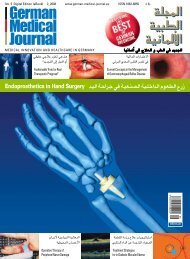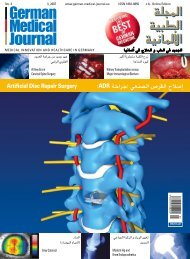Немецкий медицинский журнал Немецкий медицинский журнал
Немецкий медицинский журнал Немецкий медицинский журнал
Немецкий медицинский журнал Немецкий медицинский журнал
You also want an ePaper? Increase the reach of your titles
YUMPU automatically turns print PDFs into web optimized ePapers that Google loves.
Coronary Stents<br />
THE JOURNAL OF MEDICINE FOR THE WORLDWIDE MED COMMUNITY<br />
Коронарные стенты<br />
Risk Factors for Stent Thrombosis<br />
Patient factors<br />
Acute coronary syndrome<br />
Diabetes mellitus<br />
Renal failure<br />
Imparied left ventricular function<br />
Discontinuation of dual antiplatelet therapy<br />
Clopidogrel Non-responder<br />
Advanced age<br />
data will be expected from the<br />
randomized PROTECT trial of<br />
8,800 „all-comers“ patients assigned<br />
to treatment with either<br />
ZES or SES [27].<br />
2. The Xience-V EES<br />
The Xience-V EES, receiving<br />
EMEA and FDA approval in<br />
January 2006 and July 2008,<br />
respectively, is based on a<br />
CoCr Multi-Link Vision BMS<br />
platform (Abbott Vascular,<br />
California) coated by a formulation<br />
of everolimus, poly-n-butyl<br />
methacrylate (PBMA) and a<br />
permanent, but biocompatible<br />
co-polymer poly-vinylidene<br />
fluoride-co-hexafluoropropylene<br />
(PVDF-HFP). The drug-polymer<br />
coating is applied to the entire<br />
stent surface with a standard<br />
concentration of 100μg/cm 2 of<br />
stent surface area and is designed<br />
to release approximately<br />
80% of the total dose within<br />
30 days of stent placement,<br />
with nearly all drug released<br />
within 4 months [28].<br />
An experimental study in rabbit<br />
iliac arteries revealed more<br />
rapid and complete endothelialization<br />
with EES than with<br />
SES, PES or ZES. While reendothelialization<br />
of struts at<br />
14 days was variable among<br />
comparator stents, significantly<br />
greater coverage was seen<br />
with EES (66±27.5%), followed<br />
by ZES (30.2%±14.2%),<br />
PES (26.8%±15.8%), and SES<br />
Lesion characteristics<br />
Procedural factors<br />
Device factors<br />
Table 1: Predictors for stent thrombosis<br />
Таблица 1: Предвестники тромбоза стента<br />
(6.4%±4.2%) (p













